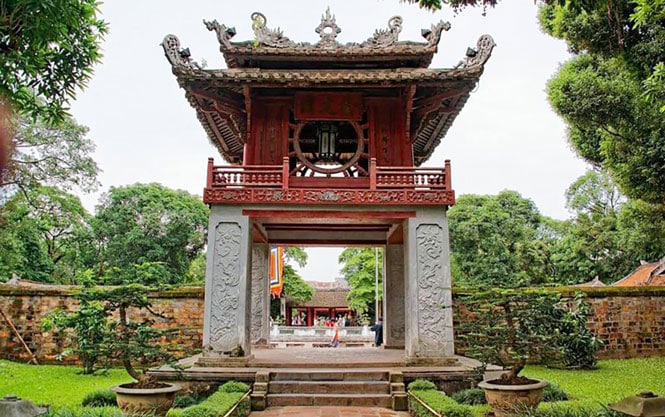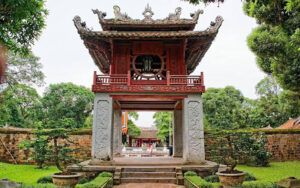Temple of Literature Hanoi is known as the first university in Southeast Asia built in the ancient Thang Long capital; This is the convergence of cultural and historical values of the Vietnamese nation.
The History of Literature Temple Hanoi
Temple of Literature was built in 1070 under King Ly Thanh Tong, it is the place to worship Confucius, Chu Cong …
In 1076, King Ly Nhan Tong established Quoc Tu Giam beside the Temple of Literature; This is a university dedicated to the king’s children and aristocratic families.
By the time of King Tran Thai Tong, Quoc Tu Giam has renamed the National Academy and accepted the children of commoners with excellent academic abilities.
In the post-Le period, the reign of King Le Thanh Tong started to build steel for those who passed the doctoral exam. In the Nguyen dynasty, Quoc Tu Giam was founded in Hue.
The renovated Thang Long Temple of Literature remains only Van Mieu of Bac Thanh town, later changed to Hanoi Temple of Literature.
The architecture of the Temple of Literature Hanoi
The current Temple of Literature Hanoi relic complex is located in the area of 54331 m2, including many different small architectural works.
Through many remodeling, this relic population includes Ho Van, Van Mieu Mon, Dai Trung Mon, Khue Van Cac, Thien Quang well, doctoral stele, Dai Thanh Mon, and Thai Hoc house.
The teaching area is located in the east and west with two rows of 14 rooms. The entire architecture of the Temple of Literature today is the architecture of the Nguyen Dynasty.
The architectural complex of Temple of Literature Hanoi is arranged for each zone, layer by layer along the North-South axis, simulating the overall planning of the Temple of Literature and Temple of Confucius worship in China; however, the scale here is simpler and follows the traditional method of national art.
In front of the Temple of Literature, there is a large lake called Van Chuong lake, the old name was Thai Ho. In addition to the main gate, there are four pillars, on the left and right sides there is a stele “Ha Ma”, surrounded by high walls.
The Gate of the Temple of Literature is built in the style of three gates.
The Temple of Literature Hanoi is divided into 5 distinct areas, each area has separated walls and a gateway to contact each other.
Where is the Temple of Literature Hanoi?
Temple of Literature is located at 58 Quoc Tu Giam, Van Mieu, Dong Da District, Hanoi, right in the middle of 4 main streets; including Nguyen Thai Hoc, Ton Duc Thang, Van Mieu, and Quoc Tu Giam.
How to get to the Temple of Literature Hanoi
If you depart from Hoan Kiem Lake, you should follow Le Thai To street; turn right onto Trang Thi street, go towards Cua Nam and Nguyen Khuyen streets; then turn left onto Van Mieu street.
Since Hanoi Street has many one-way roads, especially around the Temple of Literature, you should pay attention to avoid breaking traffic laws.
If traveling by bus, the following routes will have stops near this area: 02, 23, 38, 25, 41.
Sightseeing areas in the Temple of Literature Hanoi
Ancient banyan tree

Standing tall at the end of the brick road leading from Dai Thanh yard to the Thai Hoc area, the special national monument of Van Mieu – Quoc Tu Giam is an ancient banyan tree nearly 300 years old.
Khue Van Cac

Khue Van Cac – The symbol of the Hanoi capital is one of the most historical, cultural, and artistic works of Thang Long and the whole country.
Since 1999, Khue Van Cac has been chosen by Hanoi City as the official symbol of the capital.
“Sấm” drum

Thunder Drum (“Sấm” Drum) – The biggest drum in Vietnam in 2000, is solemnly placed at the Thai Hoc area, Temple of Literature – Quoc Tu Giam
Thai Hoc Area

The Thai Hoc project at Van Mieu-Quoc Tu Giam relic was completed on the occasion of the 990th anniversary of Thang Long-Hanoi.
Built on the old foundation of the old Quoc Tu Giam, the Thai Hoc project today becomes a cultural address – a place to organize typical cultural and educational activities of the capital Hanoi and the whole country.
The work has a very important meaning, as a link between the past and the present.
Brick wall surrounding the Temple of Literature
The row of brick walls surrounding the interior of the Temple of Literature – Quoc Tu Giam was built around the end of the 19th century.

The wall separates Giám park from the inner areas
Along with the urbanization process since the French colonial period, the overall monument has changed a lot: Ho Van is separated from the monument by Quoc Tu Giam street, part of the old foundation of Quoc Tu Giam school used as a road (street). Nguyen Thai Hoc today)…

The wall as seen from Giám park
By the early 1990s, the relic was seriously degraded, the brick wall collapsed, the foot subsided, many places were tilted, and the wall surface cracked in large intervals…
In 1995, within the framework of the project of restoration and embellishment of the Temple of Literature – Quoc Tu Giam, all these walls were restored with a unified height of 1.98m.
Giám garden
The quadrilateral green space located to the west of the Van Mieu – Quoc Tu Giam relic site along Ton Duc Thang street is the Giam garden. The garden used to have an area of 7,937 square meters.

Garden Giam has become an indispensable part of the historical site of Van Mieu – Quoc Tu Giam. Giam Garden with many green trees, lawns, octagonal houses, and fresh and airy space contributes to the preservation and preservation of the landscape, beautifying the nearly thousand-year-old historical relic.
Thien Quang Well
Thien Quang well has a square shape of 30m on each side, and balustrades decorated with green ceramic tiles. The well water is full all year round, like a mirror reflecting the sky. The well is named “Thien Quang” which means “Light of the sky”.

This place has become one of the unique check-in points for tourists when visiting Van Mieu – Quoc Tu Giam relic.
Đại Trung Gate

Dai Trung Gate has the architectural style of the Later Le Dynasty. The building is designed with three compartments without doors. The gate floor is paved with Bat Trang tiles.
Văn Miếu gate
The large gate of the Temple of Literature was built in the early twentieth century. The gate is built of brick in the form of a two-story, eight-roofed three-way gate.

The middle door is big and tall, the upper floor has three words “Van Mieu Mon” (Gate of Van Mieu). Two ironwood gates open inwards.
Van lake

Due to the importance of Lake Van, in 1998, the People’s Committee of Hanoi city repaired and embellished this area.
Currently, Ho Van is open to the public to visit and adds to the beauty of the main gate area of the Temple of Literature – Quoc Tu Giam. This is also the place to organize many meaningful cultural activities.
Dai Thanh gate

Dai Thanh Gate has the architectural style of the Later Le period (15-17 centuries). The building is made of wood and roof tiles.
Notes
- Respect monuments, and obey the regulations of the relic management unit. No harm to artifacts, or relic landscape. Do not rub turtle’s head, write, draw, stand, sit on doctor’s stele …
- The costume when coming to the Temple of Literature should be clean and neat. Don’t wear very short skirts or pants, revealing clothing, or indoor clothing. Do not smoke, wear hats in the shrine area, gallery …
- Implement a civilized life in the place of worship: No acts of lack of culture, profanity, or disorder; Having the right attitude during the ceremony, each person only lights one incense stick; Offering ceremonies, burning incense at the right place.
- It is strictly forbidden to take advantage of the freedom of belief to perform superstitious activities, gambling, fraud …
- Maintain hygiene and environmental landscape protection. Do not climb walls, climb trees, break branches, pick flowers, step on the grass, fish, swim, or throw trash indiscriminately.
- Do not bring weapons, explosives, or flammable substances into the relic.
- Keep the car in the right place, and manage personal belongings to avoid loss.
- The filming activities at Van Mieu Quoc Tu Giam can only be conducted with the consent of the leader of the relic.


